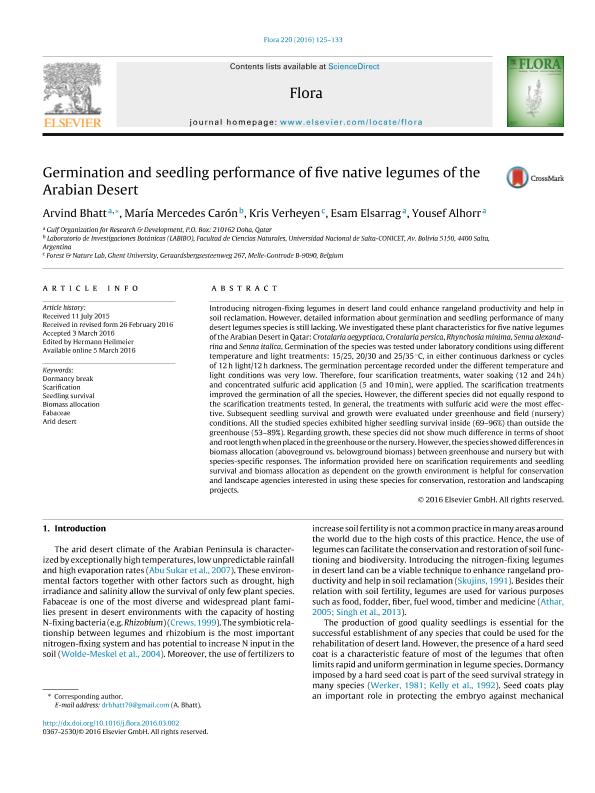Mostrar el registro sencillo del ítem
dc.contributor.author
Bhatt, Arvind
dc.contributor.author
Carón, María Mercedes

dc.contributor.author
Verheyen, Kris

dc.contributor.author
Elsarrag, Esam
dc.contributor.author
Alhorr, Yousef
dc.date.available
2018-08-15T15:25:45Z
dc.date.issued
2016-04
dc.identifier.citation
Bhatt, Arvind; Carón, María Mercedes; Verheyen, Kris; Elsarrag, Esam; Alhorr, Yousef; Germination and seedling performance of five native legumes of the Arabian Desert; Elsevier Gmbh; Flora; 220; 4-2016; 125-133
dc.identifier.issn
0367-2530
dc.identifier.uri
http://hdl.handle.net/11336/55603
dc.description.abstract
Introducing nitrogen-fixing legumes in desert land could enhance rangeland productivity and help in soil reclamation. However, detailed information about germination and seedling performance of many desert legumes species is still lacking. We investigated these plant characteristics for five native legumes of the Arabian Desert in Qatar: Crotalaria aegyptiaca, Crotalaria persica, Rhynchosia minima, Senna alexandrina and Senna italica. Germination of the species was tested under laboratory conditions using different temperature and light treatments: 15/25, 20/30 and 25/35 °C, in either continuous darkness or cycles of 12 h light/12 h darkness. The germination percentage recorded under the different temperature and light conditions was very low. Therefore, four scarification treatments, water soaking (12 and 24 h) and concentrated sulfuric acid application (5 and 10 min), were applied. The scarification treatments improved the germination of all the species. However, the different species did not equally respond to the scarification treatments tested. In general, the treatments with sulfuric acid were the most effective. Subsequent seedling survival and growth were evaluated under greenhouse and field (nursery) conditions. All the studied species exhibited higher seedling survival inside (69-96%) than outside the greenhouse (53-89%). Regarding growth, these species did not show much difference in terms of shoot and root length when placed in the greenhouse or the nursery. However, the species showed differences in biomass allocation (aboveground vs. belowground biomass) between greenhouse and nursery but with species-specific responses. The information provided here on scarification requirements and seedling survival and biomass allocation as dependent on the growth environment is helpful for conservation and landscape agencies interested in using these species for conservation, restoration and landscaping projects.
dc.format
application/pdf
dc.language.iso
eng
dc.publisher
Elsevier Gmbh

dc.rights
info:eu-repo/semantics/openAccess
dc.rights.uri
https://creativecommons.org/licenses/by-nc-sa/2.5/ar/
dc.subject
Arid Desert
dc.subject
Biomass Allocation
dc.subject
Dormancy Break
dc.subject
Fabaceae
dc.subject
Scarification
dc.subject
Seedling Survival
dc.subject.classification
Otras Ciencias Biológicas

dc.subject.classification
Ciencias Biológicas

dc.subject.classification
CIENCIAS NATURALES Y EXACTAS

dc.title
Germination and seedling performance of five native legumes of the Arabian Desert
dc.type
info:eu-repo/semantics/article
dc.type
info:ar-repo/semantics/artículo
dc.type
info:eu-repo/semantics/publishedVersion
dc.date.updated
2018-08-15T13:57:30Z
dc.journal.volume
220
dc.journal.pagination
125-133
dc.journal.pais
Alemania

dc.journal.ciudad
Jena
dc.description.fil
Fil: Bhatt, Arvind. Gulf Organization for Research & Developmen; Qatar
dc.description.fil
Fil: Carón, María Mercedes. Consejo Nacional de Investigaciones Científicas y Técnicas; Argentina. Universidad Nacional de Salta. Facultad de Ciencias Naturales. Escuela de Agronomía. Laboratorio de Investigaciones Botánicas; Argentina
dc.description.fil
Fil: Verheyen, Kris. University of Ghent; Bélgica
dc.description.fil
Fil: Elsarrag, Esam. Gulf Organization for Research & Developmen; Qatar
dc.description.fil
Fil: Alhorr, Yousef. Gulf Organization for Research & Developmen; Qatar
dc.journal.title
Flora

dc.relation.alternativeid
info:eu-repo/semantics/altIdentifier/doi/https://dx.doi.org/10.1016/j.flora.2016.03.002
dc.relation.alternativeid
info:eu-repo/semantics/altIdentifier/url/https://www.sciencedirect.com/science/article/pii/S0367253016300251
Archivos asociados
